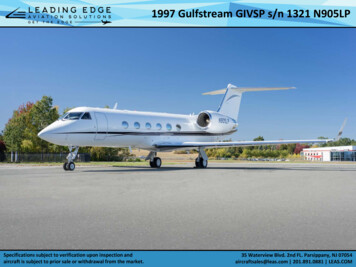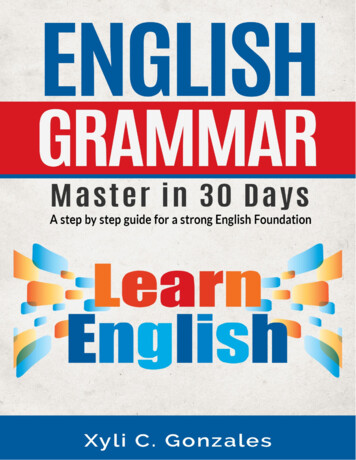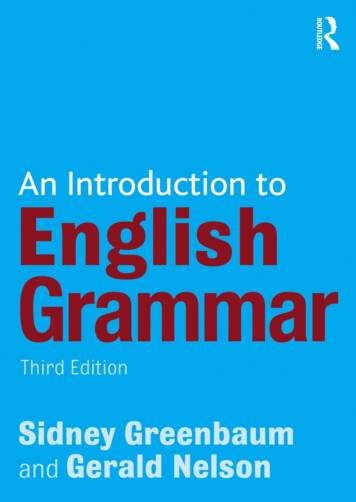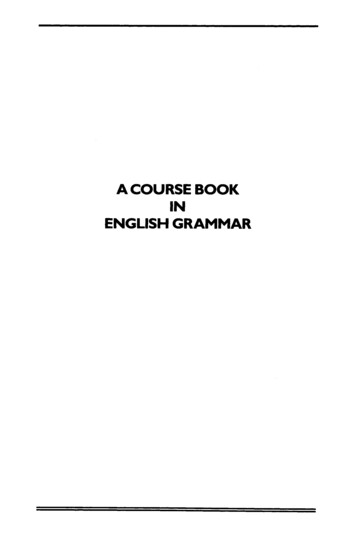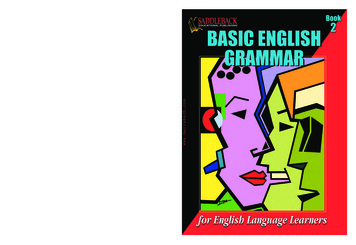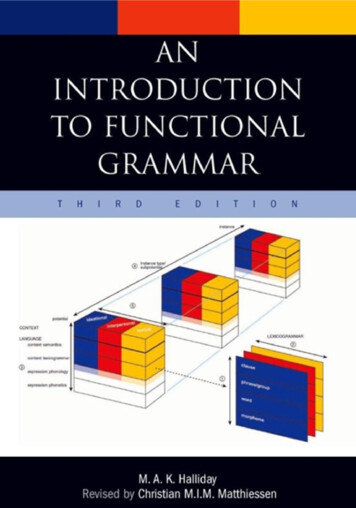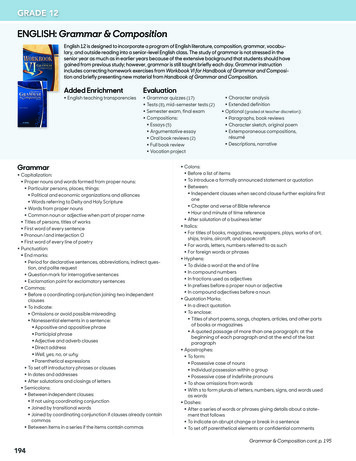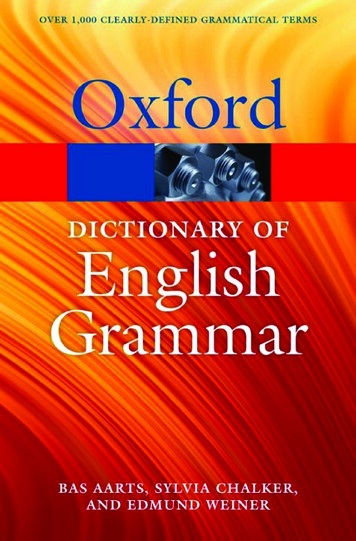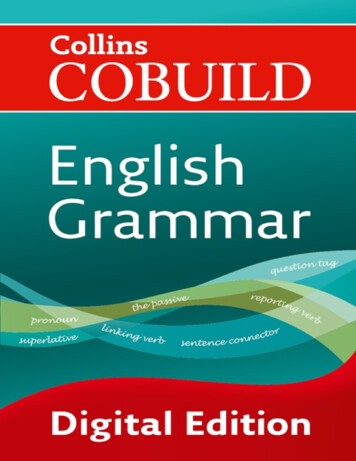
Transcription
About COBUILDWhen the first COBUILD dictionary was published in 1987, it revolutionizeddictionaries for learners. It was the first of a new generation of languagereference materials that were based on actual evidence of how English wasused, rather than lexicographer intuition.Collins and the University of Birmingham, led by the linguist John Sinclair,developed an electronic corpus in the 1980s, called the Collins BirminghamUniversity International Language Database (COBUILD). This corpus, whichfor several years was known as the Bank of English , became the largestcollection of English data in the world. COBUILD dictionary editors use thecorpus to analyse the way that people really use the language.The Collins corpus now contains 4 billion words taken from websites,newspapers, magazines and books published around the world, and fromspoken material from radio, TV and everyday conversations. New data isadded to the corpus every month, to help COBUILD editors identify newwords, grammatical structures, and meanings from the moment they are firstused.All COBUILD language reference books are based on the information oureditors find in the Collins corpus. Because the corpus is so large, our editorscan look at lots of examples of how people really use the language. The datatells us how the language is used; the function of different structures; whichwords are used together; and how often these words and structures are used.All of the examples in COBUILD language materials are examples of realEnglish, taken from the corpus. The examples have been carefully chosen todemonstrate typical grammatical patterns, typical vocabulary and typicalcontexts.COBUILD Grammar is no exception: Collins editors and researchers have beenable to use this wealth of information to establish a unique and fulldescription of English grammar, and to track the development of certaingrammatical structures over time.The corpus lies at the heart of COBUILD, and you can be confident thatCOBUILD will show you what you need to know to be able to communicateeasily and accurately in English.If you would like to learn more about the Collins corpus, or to sign up for ouronline corpus service, please go to www.collinslanguage.com/wordbanks.
Third EditionManaging EditorPenny HandsEditorial ConsultantRoger BerryLingnan University, Hong KongProject ManagerLisa SutherlandSenior Corpus ResearcherKate WildThe Grammar of Academic EnglishUniversity of Glasgow Language CentreDr Esther DabornAnneli WilliamsLouis HarrisonCorpus ResearchersGeorge DavidsonKate MohideenElizabeth PotterElspeth SummersLaura WedgeworthThe Grammar of Business EnglishSimon ClarkeAmerican English ConsultantOrin HargravesFor the PublishersLucy CooperKerry FergusonElaine HiggletonComputing SupportThomas Callan
Founding Editor-in-ChiefJohn SinclairWe would like to thank the following people for their contributions to previouseditions of the text:Maree Airlee, Mona Baker, Henri Béjoint, Adriana Bolívar, Jane Bradbury, DavidBrazil, Dominic Bree, Nicholas Brownlees, Tony Buckby, Stephen Bullon, AnnetteCapel, Michela Clari, Jane Cullen, John Curtin, Richard Fay, Gwyneth Fox, RichardFrancis, Iria Garcia, Gottfried Graustein, John Hall, M.A.K. Halliday, Patrick Hanks,Ron Hardie, Anthony Harvey, Lorna Heaslip, Michael Hoey, Roger Hunt, SueInkster, Andy Kennedy, Lorna Knight, Ramesh Krishnamurthy, Tim Lane, MarcelLemmens, Helen Liebeck, Alison Macaulay, Elizabeth Manning, Agnes Molnar,Rosamund Moon, Sue Ogden, Charles Owen, Georgina Pearce, Georgina Pert, AnnePradeilles, Christopher Pratt, Christina Rammell, Clare Ramsey, Ramiro Restrepo,Christopher Royal-Dawson, Toňi Sanchez, Katy Shaw, Sue Smith, Mary SnellHornby, Tom Stableford, John Todd, Bob Walker, Laura Wedgeworth, HermanWekker, Douglas Williamson, Jane Winn, Deborah Yuill
IntroductionThis grammar is suitable for anyone who is interested in the English languageand how it works in everyday current contexts. It has been written mainly foradvanced-level students and their teachers, but any serious learner will find ita valuable reference tool.The information in this book is taken from a long and careful study ofpresent-day English involving the analysis of the Collins corpus – a corpus ofmany millions of words of speech and writing.A functional approachMost people who study and use a language are interested in how they can dothings with the language – how they can make meanings, get attention,influence people, and learn about the world. They are interested in thegrammatical structure of the language as a way of getting things done.A grammar that puts together the patterns of the language and the things youcan do with them is called a functional grammar.This is a functional grammar; that is to say, it is based on the importantrelation between structure and function.Each chapter is built around a major function of language, such as describingpeople and things, and reporting what someone said. Each of these functions isregularly expressed in English by one particular structure. For example,describing people and things is usually expressed by adjectives, and reportingwhat people say or think typically involves a reporting verb such as say,followed by a clause beginning with that or a clause with quotation marks (‘ ’)around it.This grammar follows up each major statement (often called a rule in othergrammars) with a detailed description of the uses surrounding it – includingany exceptions. The scope of the original function may then be extended. Forexample, the basic, central function of reporting verbs (chapter 7) is to statewhat someone has said.He said he would be back soon.It can easily be extended to include what someone has written.His mother wrote that he had finally arrived home.Then it can be widened to include thoughts and feelings; these do not need tobe expressed in words, but the reporting structure is very convenient.The boys thought he was dead.From this we can see the reporting clause as a more general way of
introducing another clause.ExamplesAll the examples in this book are taken from the Collins corpus.As ever, the corpus lies at the heart of each grammar point described, helpingcompilers to make con dent and accurate decisions about di erent structuresand usage. Examples themselves remain close to the corpus, with minorchanges made so that they are more accessible to the learner. They arecarefully chosen so as to illustrate typical patterns and collocations in real-lifesituations.Groups of words that behave in the same wayAs well as providing a wealth of illustrative examples, this book gives furtherinformation about the grammar of a large number of specific words. Theactual words and phrases that are regularly used in each structure are givenin a series of lists. In this way, the learner can get a good idea of how large orsmall a grammatical class is, and how many words a certain rule applies to.Wherever there is good reason to do so, the words and phrases are groupedtogether in a list in a meaningful arrangement. So, for example, at 1.21,separate groups are set out in a single list, including animals, sh, wordsending in -craft, and foreign words ending in -s. These all share the samefeature, i.e. that they can be either singular or plural nouns without anychange in form – moose, salmon, aircraft, corps. From a purely grammaticalpoint of view, they could all go in a single alphabetical list; however from ateaching and learning point of view, it is helpful to have them furtherclassified according to their meaning.‘Be creative’Certain areas of English grammar are very exible and productive. Some arewell known, such as the fact that almost any noun in English can modifyanother noun. For example, the noun steam can be used in, among others, thefollowing combinations: steam bath, steam room, steam engine, steam iron,steam power, and steam train.With this in mind, several ‘Be creative’ features are included to encouragelearners to use their imagination, and to be more con dent about expressingthemselves. In such cases, rather than giving a de nite rule, we prefer to giveguidance so that the user can make individual choices with no serious risk oferror. By describing the language in this way, we give plenty of scope forcreativity and innovation.Accessibility
When using a grammar, it can be di cult to nd the information that youwant. This is often the biggest single problem for users of grammars, and agood reason why grammars are often unpopular with learners. This grammarmakes a special effort to support the user.We have aimed to use the most up-to-date and commonly used grammaticalterminology throughout. Technical terms have been used only where there isno obvious alternative. A glossary of terms is provided and they are also alllisted in the index.There is a contents list at the beginning of the book. Using this or the index,the user will be able to nd the section or paragraph where a function isassociated with a structure.Throughout the book there are paragraph headings that show the topic ofalmost every paragraph, and there are frequent additional headings for eachsection of a chapter. At the top of each page, there is another heading toguide the user.New developments in languageThe continued development of the corpus has enabled us to keep up with theever-changing nature of language. This third edition of COBUILD EnglishGrammar presents the results of a body of research that has been carried outon language data collected over the last 20 years. The researchers tracked thedevelopment of a set of grammatical features, including:(i) the use of the progressive with so-called stative verbs (e.g. I’m loving everyminute of it)(ii) the use of much in affirmative unmodified statements (e.g. There wasmuch debate)(iii) the spread of generic pronouns (e.g. You get some people who are verydifficult)(iv) the use of like in reporting structures (e.g. And I was like, ‘wow!’)The results were sometimes fascinating and surprising, and have enabled us toensure that this new edition of the Grammar gives you a clear portrayal ofreal English as it is written and spoken today.The grammar of academic and business EnglishIn the course of our preparation for this new edition, teachers and learnerstold us that a useful extension of our functional approach would be to focuson two main contexts in which English is used as a lingua franca throughoutthe world – academic and business English.As a result, two brand-new supplementary sections have been added. Theseidentify the principal areas of grammar that learners need to master if they
wish to communicate effectively in business and academic contexts.The academic English section covers such areas as explaining results,reviewing research, and reporting ndings. The section on the grammar ofbusiness English looks at typical structures used in such contexts as sharinginformation, negotiating, and giving presentations. Extensive crossreferencing allows the user to refer back to the main text, where structuresare discussed in greater detail.We hope that you will enjoy learning about English grammar from afunctional perspective – from exploring the wealth of real-world examples ofcurrent language, to understanding how certain structures work in academicand business contexts. We hope, too, that as a result, you will gain thecon dence to use English creatively and e ectively in a wide range ofeveryday situations.
How to use this GrammarThe Collins COBUILD English Grammar is designed to be used both for quickreference and for in-depth study.Organization of the main textThe main text of the Grammar is divided into ten chapters. The first twochapters deal with the noun phrase, chapters 3, 4, and 5 with the verbphrase. Chapter 6 deals with adverbs and prepositions, chapter 7 withreporting, chapter 8 with joining words, phrases and clauses, and chapters 9and 10 with continuous text.Each chapter consists of a series of main topics and each topic is divided intosections. Paragraphs in the chapter are numbered, so that chapter 1 runs from1.1 to 1.251, chapter 2 from 2.1 to 2.302 and so on.This numbering system makes it easy for the user to refer to different butrelated points. There are cross-references throughout the text, either pointingto the main place where a topic is dealt with or to another paragraph wheremore information is given.Most paragraphs also have a heading, saying in a few words what it dealswith, especially which grammatical structure is being explained. Someparagraph headings do not show specifically what the paragraph deals with,but indicate information of a different kind. These paragraphs have theheadings ‘Be careful’, ‘Be Creative’, and ‘Usage Note’.‘Be Careful’ highlights points where people often have problems with aparticular grammatical feature of English, for example because it is a featurewhere English is different from many other languages.‘Be Creative’ indicates that the rule that has been mentioned can be applied inEnglish to a very large number of words. For example, it is nearly alwayspossible to make the -ing participle of a verb into an adjective that is used infront of a noun. By taking note of these features, you can use the rules thathave been presented in a creative and original way, giving you greaterfreedom to express yourself in English. ‘Be Creative’ features are explained ingreater detail in the Introduction.‘Usage Note’ gives information about the use of individual words or smallgroups of words. This information is important but cannot be generalized intoa grammatical rule. The Usage Notes help you to understand points that areimportant for the understanding of particular words, rather than points thatrelate to large numbers of words.
The U.S. flag symbol highlights paragraphs containing information abouttypical American English usage.The speech bubble symbol identifies paragraphs describing structures that aremost commonly found in spoken English.Most of the grammatical explanations are followed by examples showing howthe structure is used. These examples are all taken from the Collins corpus,and show how the structures are used naturally in speech or writing. Theexamples therefore give important information about the typical use of astructure, the words it is frequently used with, and the contexts in which it islikely to occur.Throughout the book, grammatical explanations are followed by lists of thewords that typically illustrate that grammatical point. For example, inChapter 3, the point is made that many verbs can be either transitive orintransitive with the same meaning. This is followed by a list of verbs that arefrequently used in this way.The lists go beyond the actual examples of use that are given, to other wordsthat behave in similar ways. They show whether the point being made can beapplied to a small number or a large number of words. If the group is small,all members of it are given. If it is large, then the most frequently used wordsare given.These lists can be used to help you increase your vocabulary and to check thatyou are using newly learned English words correctly.Additional contentsIn addition to the main text, there are various other sections which areincluded to help you to get the most out of this Grammar. These additionalsections are described below.Glossary of grammatical termsThe Glossary explains the meaning of grammatical terms. It covers the termsthat are used in this grammar, and also includes terms that are used in othergrammars, with a cross-reference to the term used in this book, whereappropriate. For example, this grammar talks about the present progressive,whereas some other grammars call it the present continuous. Both of theseterms are mentioned in the Glossary, with the explanation being given atpresent progressive.The Reference SectionThis section at the back of the book provides an easy-to-use reference guidethat shows how the following groups of words are formed:
plurals of nouns the comparative and superlative of adjectives ‘-ly’ adverbs formed from adjectives the comparative and superlative of adverbstensesother verb formspassives principal parts of irregular verbsThe Reference Section also includes other topics. For example, it starts with apronunciation guide, to remind you of the sounds of English. There are alsolists of numbers, and an explanation of how numbers are expressed aloud.IndexThe Index is a comprehensive list of everything dealt with in the Grammar. Itcovers:(i) the grammatical and functional topics dealt with in the Grammar;(ii) individual words where they are used as examples of a particulargrammatical point;(iii) grammatical terms, both those used in this book and those commonlyused in other books.
Glossary of grammatical termsabstract noun a noun used to describe a quality, idea, or experience rather thansomething physical or concrete; e.g. joy, size, language. Compare with concretenoun.active used for describing verb phrases such as gives, and has made, where thesubject is the person or thing doing the action or responsible for the action.Compare with passive.adjectival clause another name for relative clause.adjective a word used to tell you more about a thing, such as its appearance, colour,size, or other qualities; e.g. a pretty blue dress.adverb a word that gives more information about when, how, where, or in whatcircumstances something happens; e.g. quickly, now. There are several differentkinds of adverb; adverbs of degree, manner, place, time, duration, and frequency.There are also focusing adverbs.adverbial a word or combination of words added to a clause to give moreinformation about time, place, or manner. See also sentence adverbial andsentence connector.adverb of degree an adverb indicating the amount or extent of a feeling or quality;e.g. extremely.adverb/adverbial of duration an adverb or adverbial indicating how longsomething lasts; e.g. briefly, for a long time.adverb/adverbial of frequency an adverb or adverbial indicating how oftensomething happens; e.g. often, once a week.adverb of manner an adverb indicating the way in which something happens or isdone; e.g. carefully.adverb of place an adverb that gives more information about position or direction;e.g. Move closer.adverb particle an adverb used as part of a phrasal verb; e.g. hide out, sit up, turnround.affirmative not containing a negative word. Also called positive.agent another name for performer.agreement the relationship between a subject and its verb, or between a number ordeterminer and its noun; e.g. I look/she looks one bell/three bells. Also calledconcord.apostrophe s an ending (’s) added to a noun to mark possession; e.g. Harriet’s
daughter the professor’s husband the Managing Director’s secretary.article see definite article, indefinite article.aspect the use of verb forms to show whether an action is continuing, repeated, orfinished.attributive used for describing the position of adjectives when they are used in frontof a noun. Compare with predicative.auxiliary verb one of the verbs be, have, and do when they are used with a mainverb to make verb forms, negatives, questions, and so on. Also called auxiliary.Modals are also auxiliary verbs.bare infinitive another name for infinitive without to.base form the form of a verb that has no letters added to the end and is not a pastform; e.g. walk, go, have, be. The base form is the form you look up in a dictionary.broad negative one of a small group of adverbs including barely and seldom whichare used to make a statement almost negative; e.g. I barely knew her.cardinal number a number used for counting; e.g. one, seven, nineteen.classifying adjective an adjective used to identify something as being of aparticular type; e.g. Indian, wooden, mental. They do not have comparatives orsuperlatives. Compare with qualitative adjective.clause a group of words containing a verb. See also main clause and subordinateclause.clause of manner a subordinate clause that describes the way in which somethingis done, usually introduced with as or like; e.g. She talks like her mother used to.collective noun a noun that refers to a group of people or things; e.g. committee,team.colour adjective an adjective referring to a colour; e.g. red, blue, scarlet.common noun a noun used to refer to a person, thing, or substance; e.g. sailor,computer, glass. Compare with proper noun.comparative an adjective or adverb with -er on the end or more in front of it; e.g.friendlier, more important, more carefully.complement a noun phrase or adjective that comes after a linking verb such as be,and gives more information about the subject or object of the clause; e.g. She is ateacher, She is tired, They made her chairperson.complex sentence a sentence consisting of two or more main clauses linked by asubordinating conjunction; e.g. We went inside when it started to rain.compound a combination of two or more words functioning as a unit. For example,self-centred and free-style are compound adjectives, bus stop and state of affairs arecompound nouns, and dry-clean and roller-skate are compound verbs.
compound sentence a sentence consisting of two or more main clauses linked by acoordinating conjunction; e.g. They picked her up and took her into the house.concessive clause a subordinate clause, usually introduced by although or while, thatcontrasts with a main clause; e.g. Although I like her, I find her hard to talk to.concord another name for agreement.concrete noun a noun that refers to something we can touch or see; e.g. table, dress,flower. Compare with abstract noun.conditional clause a subordinate clause usually starting with if. The eventdescribed in the main clause depends on the condition described in the subordinateclause; e.g. If it rains, we’ll go to the cinema They would be rich if they had takenmy advice.conjunction a word linking together two clauses, phrases, or words. There are twotypes of conjunction – coordinating conjunctions, which link parts of a sentenceof the same grammatical type (and, but, or), and subordinating conjunctions,which begin subordinate clauses (although, when).continuous another name for progressive.contraction a shortened form in which an auxiliary verb and not, or a subject andan auxiliary verb, are joined together and function as one word; e.g. aren’t, she’s.coordinate clause a clause that is connected to another clause with a coordinatingconjunction such as and or but; e.g. He fell and broke his leg.coordinating conjunction a word such as and, but, or or which joins together twoclauses, phrases, or words of the same grammatical type.copula a name sometimes used to refer to the verb be. In this grammar, the termlinking verb is used.countable noun a noun that can be singular or plural; e.g. dog/dogs, lemon/lemons,foot/feet. Also called count noun.declarative a clause in the declarative form has the subject followed by the verb.Most statements are made in the declarative form. Also called indicative.defining non-finite clause a participle clause that is placed after a noun phrase toidentify the person or thing you are talking about; e.g. The girl wearing the red hat.defining relative clause a relative clause that identifies the person or thing that isbeing talked about; e.g. I wrote down everything that she said.definite article the determiner ‘the’.delexical verb a verb that has very little meaning in itself and is used with anobject that carries the main meaning of the structure. Give, have, and take arecommonly used as delexical verbs; e.g. She gave a small cry I’ve had a bath.demonstrative one of the words this, that, these, and those used in front of a noun;e.g. this woman that tree. They are also used as pronouns; e.g. That looks
nice This is fun.dependent clause another name for subordinate clause.definite determiner one of a groups of determiners including the, that and yourwhich you use when the person you are speaking to understands which person orthing you are talking about; e.g. the old man, my ideas.determiner one of a group of words including the, a, some, and my which are usedat the beginning of a noun phrase.direct object a noun phrase referring to a person or thing affected by an action, ina sentence with an active verb; e.g. She wrote her name . I shut the windows.direct speech speech reported in the words actually spoken by someone, withoutany changes in tense, person, and so on.ditransitive verb a verb such as give, take, or sell which can have both an indirectand a direct object; e.g. She gave me a kiss.dynamic verb a verb such as run, give or slice which describes an action. Comparewith stative verb.-ed adjective an adjective that ends in -ed, and usually has the same form as the -edparticiple of a verb, or is formed by adding -ed to a noun; e.g. a worried look skilled workers. Adjectives that do not end in -ed but have the same forms asirregular -ed participles are also called -ed adjectives; e.g. a broken bone.-ed participle a verb form such as walked or played, which is used to make perfectforms and passives, or in some cases an adjective. Irregular participles such asgiven and broken are also called -ed participles because they behave like regular ed participles. Also called past participle.ellipsis when you leave out words because they are obvious from the context.emphasizing adjective an adjective such as complete, utter or total which stresseshow strongly you feel about something; e.g. I feel a complete fool.ergative verb a verb that can be either transitive or intransitive in the samemeaning. To use the verb intransitively, you use the object of the transitive verbas the subject of the intransitive verb; e.g. He had boiled a kettle The kettle hadboiled.exclamation a word or sentence spoken suddenly and loudly in order to expresssurprise, anger, and so on; e.g. Oh gosh!finite a finite verb is inflected according to person or tense rather than being aninfinitive or a participle.first person see person.focusing adverb a sentence adverb that indicates the most relevant thing involved;e.g. only, mainly, especially.future the use of will or shall with the base form of the verb to refer to future events;
e.g. She will come tomorrow.future progressive the use of will be or shall be and an -ing participle to refer tofuture events; e.g. She will be going soon. Also called future continuous.future perfect the use of will have or shall have and an -ed participle to refer tofuture events; e.g. I shall have finished tomorrow.future perfect progressive the use of will or shall with have been and an -ingparticiple to refer to future events; e.g. I will have been walking for three hours bythen. Also called future perfect continuous.gender a grammatical term referring to the difference between masculine andfeminine words such as he and she.generic pronoun one of a group of pronouns including you and they which are usedto refer to people in general.gerund another name for -ing noun.gradable a gradable adjective can be used with a word such as very to say that theperson or thing referred to has more or less of a quality; e.g. very boring, lesshelpful.idiom a group of two or more words with a meaning that cannot be understood bytaking the meaning of each individual word; e.g. to kick the bucket, to run wild.if-clause a conditional clause; or a clause used to report a yes/no-question.imperative a clause in the imperative has the base form of the verb without asubject, e.g. Come here Take two tablets every four hours Enjoy yourself.impersonal it it is an impersonal subject when it is used to introduce a fact, orwhen it is used in a split sentence; e.g. It’s raining It was you who asked.indefinite article the determiners a and an.indefinite determiner one of a group of determiners including a, many and severalwhich you use to refer to someone or something of a particular type, withoutsaying which person or thing you mean; e.g. an old man, several suggestions.indefinite place adverb one of a group of adverbs including anywhere andsomewhere which are used to indicate position or location in a general or vagueway.indefinite pronoun one of a group of pronouns including someone and anythingwhich are used to refer to a person or thing in a general way.indicative another name for declarative.indirect object a second object used with a transitive verb to indicate who or whatbenefits from an action, or gets something as a result of it; e.g. She gave me a rose.indirect question another name for reported question.indirect speech another name for reported speech.
infinitive the base form of a verb. It is often used with to in front of it; e.g. (to) take,(to) see, (to) bring.infinitive without to the infinitive form without to in front of it, used with modalsand certain other verbs; e.g. You must go Let me think.inflection the variation in the form of a word to show differences in tense, number,case, and degree.-ing adjective an adjective that has the same form as the -ing participle of a verb;e.g. a smiling face a winning streak.-ing participle a verb form ending in -ing that is used to make verb forms, and as anadjective. Also called the present participle.-ing noun a noun that has the same form as the -ing participle of a verb; e.g.Swimming is good for you.interjection another name for exclamation.interrogative adverb one of the adverbs how, when, where, and why when they areused to ask questions.interrogative a clause in the interrogative form has part or all of the verb phrase infront of the subject. Most questions are asked in the interrogative form.interrogative pronoun one of the pronouns who, whose, whom, what, and whichwhen they are used to ask questions.intransitive verb a verb that is used to talk about an action or event that onlyinvolves the subject and so does not have an object; e.g. She arrived I wasyawning.inversion changing the word order in a sentence, especially changing the order ofthe
How to use this Grammar The Collins COBUILD English Grammar is designed to be used both for quick reference and for in-depth study. Organization of the main text The main text of the Grammar is divided into ten chapters. The first two chapters deal with the noun phrase, chapters 3, 4, and 5 with the verb phrase.

